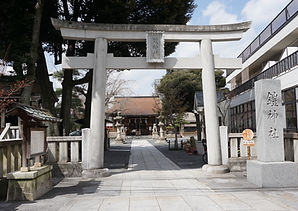普通の外にいくつかの著名な品質を持っている、と畏敬の念を起こさせるあるいかなるビーイングは、カミと呼ばれています。
Nearest station
Ōkubo
Chūō Line
Tōkyō-to, Shinjuku-ku, Kita-Shinjuku 3-16-18
東京都新宿区北新宿3-16-18
鎧神社
Yoroi Jinja
Home page: (Japanese)
March 31, 2018
Enshrined Kami:
Main
Yamato Takeru-no-Mikoto 186E 日本武尊
Ōnamuchi-kami 大己貴神
Sukunabi-kona-no-kami (101) 少名毘古那神
Taira no Masakado 平将門公
From Merged Shrines
None
In-ground Shrines:
Tenjin-sha 天神社
Inari-sha 稲荷社
Mitsumine-sha 三峯社
Nenogongen-sha 子の権現社
Annual Festival: September 15/16
History
The shrine is said to have been founded sometime during the reign of the 60th Emperor, Daigo (897-930), by a monk, Jōsū (貞崇), one of the ten disciples of Shōbō, a prominent monk of the Shingon sect and founder of one of the Shingon Shugendō sects. Jōsū had possession of a highly venerated image of Yakushi Nyorai made by the Nara Period monk, Gyōki (行基, 668-749) and he enshrined this in a temple which later became known as Enshō-ji (円照寺): along with the foundation of the temple a shrine was built at its northeast to protect the temple against the evil influence thought to emanate from that direction. This was Yoroi Jinja, and Enshō-ji served as its betto-ji.
Yoroi means armour, and there are several traditions linking the shrine name to its meaning. One of these has it that when Yamato Takeru was on his campaign to subdue the savage Emishi of the eastern provinces he buried a complete set of armour (consisting of six items) in the area where the shrine was later built. Some accounts link the shrine to Fujiwara Hidesato and Taira Masakado, two inveterate enemies of the time. One account says that after the former had killed and beheaded the latter he buried his armour and built a small shrine on the spot.


This became known as Yoroi Myōjin, a name which was retained until late in the Edo Period. An extension of this has Fujiwara falling gravely ill and visiting Enshō-ji to pray to the spirit of Taira‘s armour to lift the curse which he thought had been placed on him in revenge for the killing and building a small shrine on the spot. Again, there is an old pine tree, the kabuto matsu, lit. helmet tree, in front of the shrine and this is said to mark the spot where Masakado’s helmet is buried. It seems that the local villagers worshipped Taira Masakado at the Yoroi Myōjin, but with the coming of the Meiji Restoration he was deemed to have been a traitor to the Imperial Court and his spirit was moved to a subordinate shrine. After 1945, however, he was again enshrined in the main hall in response to pleas from local people.
Description
The most interesting of this shrine for me is the pair of koma-inu at the subordinate shrine, Tenjin-sha
(Click on images to expand them)


















